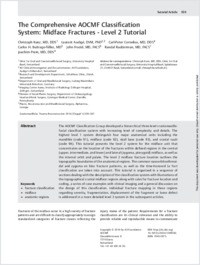The Comprehensive AOCMF Classification System: Midface Fractures - Level 2 Tutorial.
- Kunz C Clinic for Oral and Craniomaxillofacial Surgery, University Hospital Basel, Switzerland.
- Audigé L AO Clinical Investigation and Documentation, AO Foundation, Audige's Dübendorf, Switzerland ; Research and Development Department, Schulthess Clinic, Zürich, Switzerland.
- Cornelius CP Department of Oral and Maxillofacial Surgery, Ludwig Maximilians Universität München, Germany.
- Buitrago-Téllez CH Imaging Center Aarau, Institute of Radiology Zofingen Hospital, Zofingen, Switzerland.
- Frodel J Division of Facial Plastic Surgery, Department of Otolaryngology-Head and Neck Surgery, Geisinger Medical Center, Danville, Pennsylvania.
- Rudderman R Plastic, Reconstruction and Maxillofacial Surgery, Alpharetta, Georgia.
- Prein J Department of Oral and Maxillofacial Surgery, Ludwig Maximilians Universität München, Germany.
- 2014-12-10
Published in:
- Craniomaxillofacial trauma & reconstruction. - 2014
English
The AOCMF Classification Group developed a hierarchical three-level craniomaxillofacial classification system with increasing level of complexity and details. The highest level 1 system distinguish four major anatomical units including the mandible (code 91), midface (code 92), skull base (code 93), and cranial vault (code 94). This tutorial presents the level 2 system for the midface unit that concentrates on the location of the fractures within defined regions in the central (upper, intermediate, and lower) and lateral (zygoma, pterygoid) midface, as well as the internal orbit and palate. The level 2 midface fracture location outlines the topographic boundaries of the anatomical regions. The common nasoorbitoethmoidal and zygoma en bloc fracture patterns, as well as the time-honored Le Fort classification are taken into account. This tutorial is organized in a sequence of sections dealing with the description of the classification system with illustrations of the topographical cranial midface regions along with rules for fracture location and coding, a series of case examples with clinical imaging and a general discussion on the design of this classification. Individual fracture mapping in these regions regarding severity, fragmentation, displacement of the fragment or bone defect is addressed in a more detailed level 3 system in the subsequent articles.
- Language
-
- English
- Open access status
- green
- Identifiers
-
- DOI 10.1055/s-0034-1389560
- PMID 25489391
- Persistent URL
- https://folia.unifr.ch/global/documents/5885
Statistics
Document views: 11
File downloads:
- fulltext.pdf: 0
